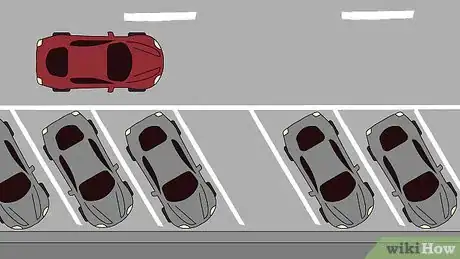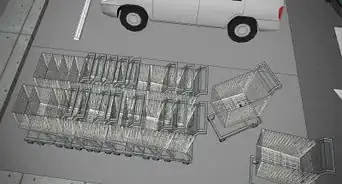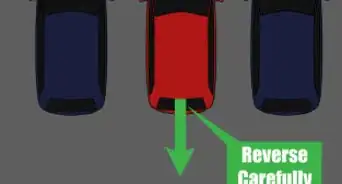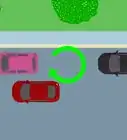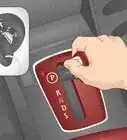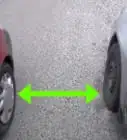This article was co-authored by Simon Miyerov. Simon Miyerov is the President and Driving Instructor for Drive Rite Academy, a driving academy based out of New York City. Simon has over 8 years of driving instruction experience. His mission is to ensure the safety of everyday drivers and continue to make New York a safer and efficient driving environment.
There are 7 references cited in this article, which can be found at the bottom of the page.
This article has been viewed 128,548 times.
Angled parking spots let drivers glide into them quickly and efficiently with minimal steering. You’ll probably find angled parking spots in high-traffic areas like cities and parking garages, though they’re also common on one-way streets. Because of how little maneuvering is involved, learning to park at an angle couldn’t be easier!
Steps
Pulling In
-
1Locate a parking spot. Angled parking spots are most common in high-traffic areas, so spots may come and go quickly. Look for spaces between cars or other drivers who are preparing to leave.[1]
- You’ll commonly find angled parking spots in commercial lots, multilevel garages, and busy side streets.[2]
-
2Put on your turn signal and check for traffic. Using your turn signal will tell the cars behind you why you’re slowing down, and prevent anyone else from trying to park in your spot.[3]
- Always check for traffic, pedestrians, and other potential obstacles, even when you’re just parking.
Advertisement -
3Turn into the spot carefully. Start turning into the spot when your mirrors are even with the line on the side nearest you. When in doubt, go slowly rather than quickly, to avoid overshooting the spot or crashing.[4]
-
4Finish pulling into the spot. Continue turning until the front of your car is in line with the cars next to you. Come to a stop at the line, curb, or wall that marks the spot, being careful not to bump into anything and damage the front of your car.[5]
-
5Put your car into park. Keep your foot on the brake until you’re securely parked. If you’re parking on an incline, pull the parking brake to prevent your car from rolling down the hill.[6]
Backing Out
-
1Put the car in reverse. If you’re using the parking break, don’t forget to disengage the parking brake before driving.[7]
-
2Check behind you for cross traffic. Cross traffic may be hard to see in an angled spot, so you can also back out slowly and check again for oncoming traffic. Don’t start backing out fully until you’re sure no one is approaching.
-
3Pull straight out the parking spot, slowly. Don’t start turning the wheel yet or you might hit the cars beside you. Check again for oncoming traffic once your line of sight is clear, and stop if you see another car coming -- they have the right of way.
-
4Turn the wheel once you’re halfway out of the spot. Turn the same way you turned into the spot -- angled sports are meant to be exited the same way they were entered. Turning your wheel the wrong way will force a much sharper turn. Aim for a smooth, loose arc, and reverse until your car is on the road, pointed straight ahead.[8]
-
5Shift your car into drive and rejoin the flow of traffic. Before you start moving, make sure your steering wheel is straightened and not pointing into the parking spot. Keep an eye out for nearby drivers exiting their parking spots.
- Watch your speed until you’re out of the parking lot or garage.
Expert Q&A
Did you know you can get expert answers for this article?
Unlock expert answers by supporting wikiHow
-
QuestionWhat should you remember when pulling into an angled parking spot?
 Simon MiyerovSimon Miyerov is the President and Driving Instructor for Drive Rite Academy, a driving academy based out of New York City. Simon has over 8 years of driving instruction experience. His mission is to ensure the safety of everyday drivers and continue to make New York a safer and efficient driving environment.
Simon MiyerovSimon Miyerov is the President and Driving Instructor for Drive Rite Academy, a driving academy based out of New York City. Simon has over 8 years of driving instruction experience. His mission is to ensure the safety of everyday drivers and continue to make New York a safer and efficient driving environment.
Driving Instructor
-
QuestionIs 1 on an automatic gear the same as L?
 Community Answer1 does not mean L. Every automatic car has its own numerology. L means low gear, and it may go up to second or third gear. 1 usually means first gear.
Community Answer1 does not mean L. Every automatic car has its own numerology. L means low gear, and it may go up to second or third gear. 1 usually means first gear.
References
- ↑ http://www.today.com/health/parking-psychology-best-ways-find-spot-every-time-t102886
- ↑ http://www.parking-net.com/about-parking/car-parking-techniques
- ↑ https://driversed.com/driving-information/driving-techniques/angle-parking.aspx
- ↑ https://www.youtube.com/watch?v=fSW00Albuic
- ↑ https://www.youtube.com/watch?v=ysX8-QQ3_0I
- ↑ http://www.driversedguru.com/driving-articles/car-auto-maintenance/always-set-the-parking-brake/
- ↑ http://drivinginstructorblog.com/reversingbacking-basics/
- ↑ https://www.youtube.com/watch?v=ysX8-QQ3_0I
About This Article
To angle park, start by finding an open parking spot and putting on your turn signal to indicate to other drivers that you're preparing to park. Then, once you've made sure there aren't any vehicles or pedestrians in your way, pull up closer to the spot. When your mirrors are even with the line that's closest to you, start turning into the spot, going slowly so you don't overshoot and hit a nearby car. Finally, come to a stop once the front of your car reaches the line or curb at the front of the spot. To learn how to back out of an angled parking spot, scroll down!
